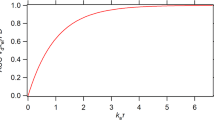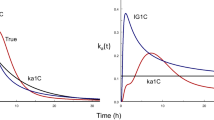Abstract
The determination of the area under the concentration–time curve (AUC) is the method most commonly used by regulatory agencies to assess extent of drug absorption after single-dose administration of oral products. Using simulations, several approaches toward measuring the actual area, in whole or part, were tested. In addition, the performance of the peak concentration (C max), usually taken as a measure of the rate of absorption was assessed evaluating extent. Model scenarios for drugs with typical mean characteristics and statistical distributions were investigated. Using different kinetic models of disposition, the time course of the drug concentration in plasma was simulated. Intraindividual and interindividual variability and assay error were modeled using Monte Carlo techniques. The accuracy, precision, and ease of use of the various measures of extent were evaluated, and statistical power analyses were performed. Among the measures tested, the most reliable were the AUC computed up to the time of the last quantifiable concentration, without extrapolation, and C max. However, being also sensitive to rate, C max as a measure of extent is of limited potential.
Similar content being viewed by others
REFERENCES
T. Colton. Statistics in Medicine, Little, Brown, Boston, 1974.
S. K. Park and K. W. Miller. Random number generators: Good ones are hard to find. Commun. ACM 31:1192–1201 (1988).
W. H. Press, B. P. Flannery, S. A. Teukolsky, and W. T. Vetterling. Numerical Recipes in C, Cambridge University Press, Cambridge, MA, 1988.
A. Racine-Poon and A. F. Smith. Population models. In D. A. Berry (ed.), Statistical Methodology in the Pharmaceutical Sciences, Marcel Dekker, New York, 1990, pp. 139–162.
D. J. Schuirmann. A comparison of the two one-sided tests procedure and the power approach for assessing the equivalence of average bioavailability. J. Pharmacokin. Biopharm. 15:657–680 (1987).
Food and Drug Administration—Office of Generic Drugs—Division of Bioequivalence. Guidance on statistical procedures for bioequivalence studies using a standard two-treatment crossover design, 1992.
Author information
Authors and Affiliations
Rights and permissions
About this article
Cite this article
Bois, F.Y., Tozer, T.N., Hauck, W.W. et al. Bioequivalence: Performance of Several Measures of Extent of Absorption. Pharm Res 11, 715–722 (1994). https://doi.org/10.1023/A:1018932430733
Issue Date:
DOI: https://doi.org/10.1023/A:1018932430733




